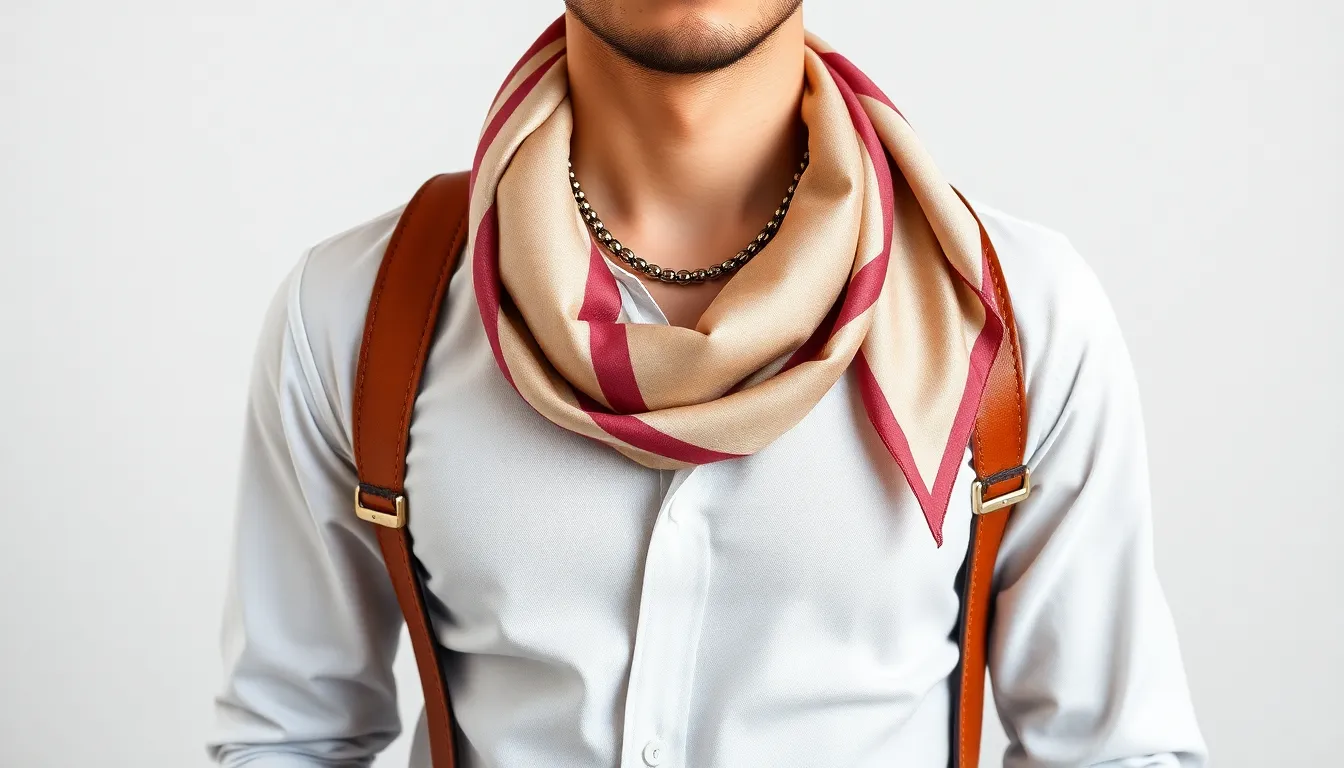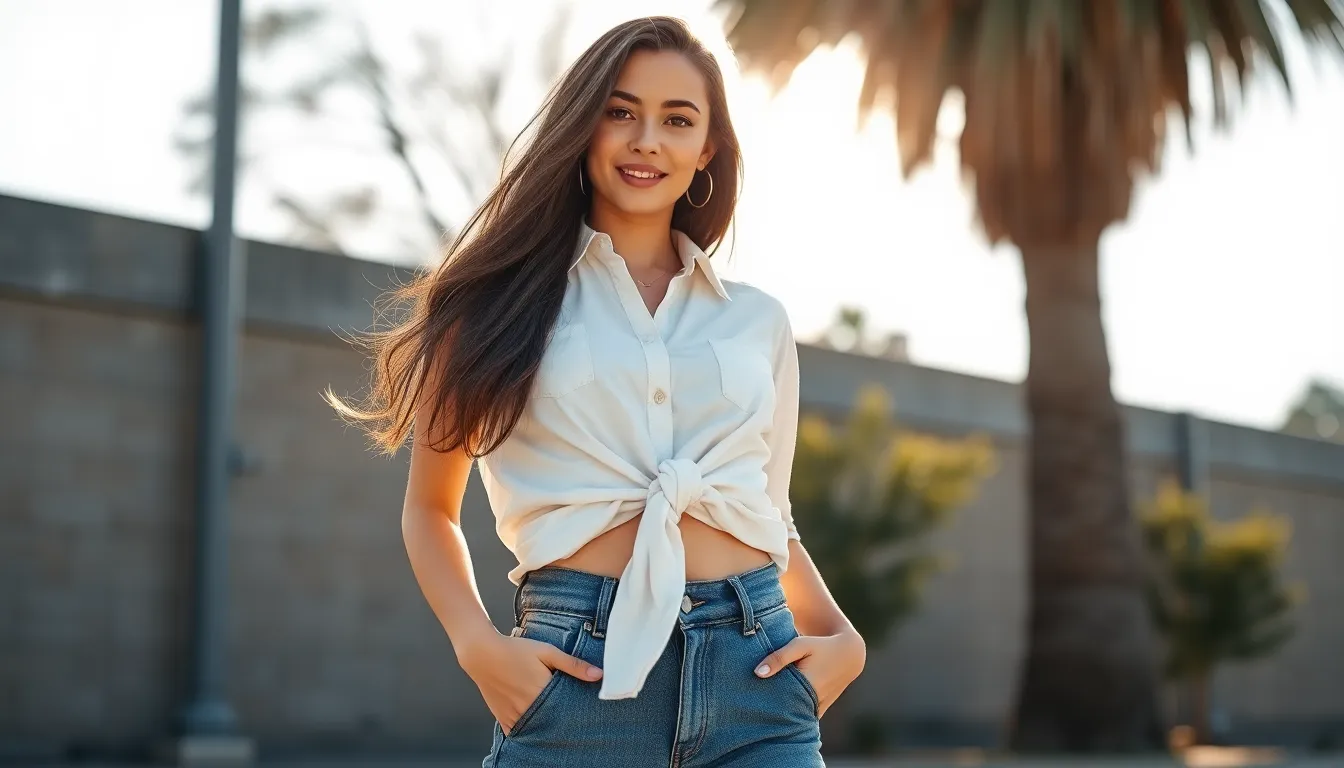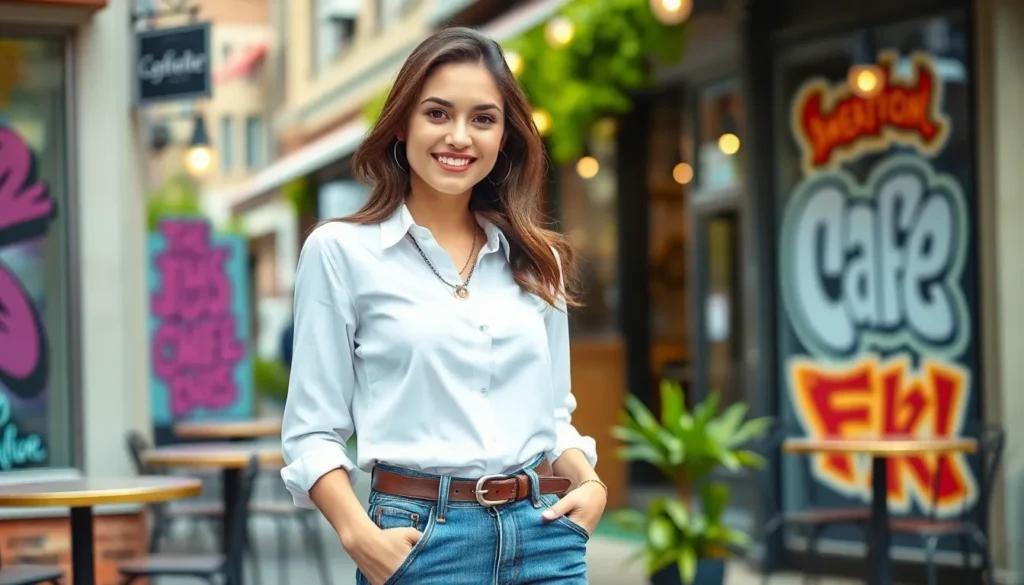We’ve all stood in front of our closets staring at that perfect shirt wondering how to make it work for different occasions. Whether it’s a crisp white button-down or a casual graphic tee the right styling techniques can transform any shirt from basic to brilliant.
The truth is most people underestimate the power of proper shirt styling. We’re talking about simple tricks that’ll help you create dozens of unique looks from just a few key pieces in your wardrobe. From tucking techniques to layering secrets these styling methods work for every body type and personal aesthetic.
Ready to unlock your shirt’s full potential? We’re about to share the essential styling strategies that fashion experts use to create effortlessly chic outfits. You’ll discover how to elevate your everyday looks and make every shirt in your closet work harder for you.
Choose the Right Shirt Fit for Your Body Type
Getting the right fit transforms any shirt from basic to brilliant. We’ve found that understanding your body type and choosing appropriate fits makes all the difference in creating polished, professional looks.
Understanding Different Fit Categories
Slim fit shirts hug your torso closely and work best for lean or athletic builds. These fitted styles create clean silhouettes without excess fabric bunching around your waist or chest.
Regular fit options provide comfortable room through the chest and waist area. We recommend this classic cut for most body types since it offers versatility without being too tight or loose.
Relaxed fit styles give you extra space throughout the torso and arms. Broader builds and those preferring comfort over form-fitting looks find these cuts most flattering.
Customized fit designs strike a balance between slim and regular cuts. These shirts follow your natural body lines while allowing enough room for comfortable movement throughout the day.
Measuring Yourself for the Perfect Fit
Neck measurements require wrapping a tape measure around your collar area where a shirt would naturally sit. Add half an inch to this measurement for comfortable breathing and collar movement.
Chest sizing involves measuring around the fullest part of your chest with arms relaxed at your sides. We suggest adding 4-6 inches to this measurement for regular fit shirts or 2-4 inches for slim fit styles.
Shoulder width determines how well a shirt will hang on your frame. Measure from shoulder point to shoulder point across your back to ensure proper drape and comfort.
Sleeve length starts at your shoulder seam and extends to where you want the cuff to end. Most people prefer sleeves that hit just above the wrist bone when arms are extended.
Common Fit Mistakes to Avoid
Buying shirts too large creates unflattering bulk and makes you appear bigger than you are. Excess fabric around the waist and chest destroys the clean lines that make shirts look expensive.
Choosing overly tight fits restricts movement and creates pulling across buttons or seams. We notice this especially affects the chest area and can cause shirts to gap between buttons.
Ignoring shoulder fit leads to shirts that never look right regardless of other adjustments. Shoulders that are too wide make you look smaller while narrow shoulders create pulling and discomfort.
Skipping length considerations results in shirts that are either too short when tucked or too long when worn untucked. The ideal length hits just below your belt line for tucked styles or at mid-hip for casual wear.
Master the Art of Tucking Your Shirt

Mastering different tucking techniques transforms how we present ourselves and creates polished looks for any occasion. Each tucking method serves exact styling purposes and works better with certain outfits and body types.
The Full Tuck Method
Full tucking creates the most formal and structured appearance when we want a clean, professional look. We achieve this by tucking the entire shirt hem completely into our pants or skirt, ensuring no fabric peeks out at the waistline.
Benefits of full tucking include:
- Creates a streamlined silhouette that elongates the torso
- Works perfectly for business meetings, formal events, and professional settings
- Pairs exceptionally well with blazers, suit jackets, and structured outerwear
- Helps define the waistline for a more customized appearance
Best practices for full tucking:
- Smooth out wrinkles around the waistband before securing with a belt
- Choose shirts with appropriate length that won’t bunch up excessively
- Ensure the shirt stays tucked by selecting proper rise pants or skirts
- Adjust the tuck throughout the day to maintain the crisp appearance
The Half Tuck Technique
Half tucking offers a casual yet intentional styling approach that works beautifully for everyday wear and relaxed occasions. We create this look by tucking only the front portion of our shirt while leaving the back and sides loose.
Strategic placement makes half tucking successful:
- Focus on tucking just the center front section, about 6 inches wide
- Keep the sides and back flowing naturally for a balanced silhouette
- Works best with mid rise to high rise bottoms that sit at the natural waist
- Ideal for creating visual interest with layered looks and casual outfits
Styling opportunities with half tucking:
- Pairs perfectly with high waisted jeans, skirts, and shorts
- Creates a flattering shape that highlights the waistline without appearing too formal
- Allows for easy movement and comfort throughout the day
- Works with both fitted and slightly oversized shirts for different aesthetic effects
The French Tuck Style
French tucking delivers an effortlessly chic appearance that bridges the gap between casual and polished styling. We execute this technique by tucking just a small section of the shirt front into our bottoms, creating an asymmetrical and relaxed vibe.
Key elements of the French tuck:
- Tuck only 2 to 3 inches of fabric on one side of the shirt front
- Leave the majority of the shirt untucked for a naturally undone appearance
- Position the tuck slightly off center for the most authentic look
- Adjust the tuck to appear casual and unforced
Perfect occasions for French tucking:
- Weekend brunches, coffee dates, and casual social gatherings
- Shopping trips, casual office environments, and creative workspaces
- Layering under cardigans, lightweight sweaters, and open blazers
- Travel outfits that need to look put together without being restrictive
- Works exceptionally well with button down shirts, blouses, and t shirts
- Pairs beautifully with high waisted jeans, trousers, and A line skirts
- Creates visual balance when wearing statement accessories or bold patterns
- Complements both fitted and relaxed bottom silhouettes
Layer Your Shirt for Added Dimension

Layering transforms a simple shirt into a sophisticated ensemble that adapts to changing weather and occasions. We’ll explore proven techniques that add visual interest and practical versatility to your shirt styling repertoire.
Wearing Shirts Under Sweaters and Cardigans
Choose lightweight shirts made from cotton or cotton blends when layering under sweaters to prevent bulk around your torso. Oxford shirts, dress shirts, and lightweight chambray options work exceptionally well as base layers.
Position your shirt collar strategically by allowing it to peek out slightly above the sweater neckline. This creates a polished layered look that frames your face naturally and adds professional appeal to casual knitwear.
Coordinate colors by selecting shirts that complement rather than match your sweater perfectly. Navy shirts pair beautifully with gray cardigans, while white shirts enhance virtually any sweater color for classic styling.
Adjust sleeve lengths so your shirt cuffs extend approximately half an inch beyond your sweater sleeves. This deliberate exposure creates visual balance and prevents your arms from appearing disproportionately short.
Select appropriate necklines by pairing crew neck sweaters with button down shirts or v neck cardigans with polo shirts. Each combination offers distinct styling opportunities for different occasions and personal preferences.
Layering with Blazers and Jackets
Master the blazer shirt combination by ensuring your shirt collar sits properly beneath the blazer lapels without bunching or folding awkwardly. Spread collar shirts work particularly well with wide lapel blazers, while point collars complement narrow lapel styles.
Calculate proper shirt length so it extends slightly below your blazer hem when worn unbuttoned. This creates a sophisticated silhouette that maintains proportional balance throughout your entire outfit.
Coordinate patterns by pairing solid colored shirts with patterned blazers or subtle striped shirts with solid jackets. Mixing patterns requires careful attention to scale and color harmony to avoid overwhelming your overall appearance.
Button strategically by leaving your shirt’s top button undone when wearing a blazer without a tie. This creates a more relaxed yet refined look that’s appropriate for business casual environments and social occasions.
Choose complementary textures by combining smooth cotton shirts with textured blazers like tweed or corduroy. These material contrasts add visual depth and interest to your layered outfit without competing for attention.
Adding Vests and Waistcoats
Incorporate sweater vests over button down shirts to create a preppy, academic inspired look that’s perfect for transitional weather. V neck sweater vests showcase your shirt and tie combination while adding warmth around your core.
Style formal waistcoats with dress shirts for special occasions requiring elevated elegance. Ensure your waistcoat hem sits at or slightly below your belt line while allowing your shirt collar to remain visible and properly positioned.
Experiment with casual vests like quilted options or utility vests over flannel shirts for outdoor activities and weekend adventures. These functional layers provide practical benefits while maintaining a put together appearance.
Adjust vest buttoning by leaving the bottom button unfastened on formal waistcoats, following traditional menswear etiquette. This prevents pulling and maintains proper drape across your torso throughout the day.
Balance proportions by choosing vests that complement your body type and shirt fit. Slim fit shirts work best with fitted vests, while regular fit shirts pair naturally with standard cut vest styles.
Accessorize Your Shirt to Elevate the Look

Accessories transform ordinary shirts into extraordinary outfits that reflect your personal style. Strategic accessory choices can take your shirt styling from basic to brilliant with minimal effort.
Choosing the Right Belt
Belts anchor your shirt styling and create a polished silhouette that defines your waistline. Leather belts work best for formal tucked shirts, while fabric belts complement casual looks perfectly.
Match your belt width to your shirt’s formality level for optimal visual balance. Dress shirts pair beautifully with belts measuring 1 to 1.25 inches wide, while casual button-ups look fantastic with wider options up to 1.5 inches.
Consider your belt buckle’s prominence when styling different shirt looks. Minimalist buckles enhance professional outfits without competing for attention, whereas statement buckles can become focal points for weekend casual styling.
Color coordination creates cohesive outfits that appear thoughtfully assembled. Brown leather belts complement earth-toned shirts like olive, beige, and cream, while black belts work seamlessly with navy, white, and gray shirts.
Adding Statement Jewelry
Jewelry introduces personality into your shirt styling while maintaining sophistication. Watches serve as foundational pieces that complement any shirt style, from formal dress shirts to casual button-ups.
Layer necklaces strategically to create visual interest without overwhelming your shirt’s neckline. Start with a shorter chain at collar level, then add a longer pendant that falls mid-chest for balanced proportions.
Cufflinks elevate dress shirts instantly, transforming standard looks into refined ensembles. Silver cufflinks complement cool-toned shirts in blues and grays, while gold options enhance warm-toned shirts in yellows and oranges.
Ring selection should complement your overall styling without competing with other accessories. Classic signet rings work beautifully with formal shirt looks, while modern bands enhance contemporary casual styling.
Brooches offer unexpected styling opportunities for both men’s and women’s shirts. Position them on lapels, collar points, or pocket areas to create unique focal points that showcase your personal style.
Incorporating Scarves and Ties
Scarves add versatility to shirt styling across seasons and occasions. Silk scarves create elegant looks when draped loosely around the neck over unbuttoned shirts, while cotton scarves offer casual comfort for everyday styling.
Tie selection depends on your shirt’s collar style and overall formality level. Spread collars accommodate wider ties measuring 3.5 to 4 inches, while button-down collars pair perfectly with narrower ties around 3 to 3.25 inches wide.
Pattern mixing creates ever-changing visual interest when done thoughtfully. Striped shirts look stunning with polka dot ties or floral scarves, while solid shirts provide perfect canvases for bold patterns and vibrant colors.
Knot styles influence your overall shirt styling impact significantly. Four-in-hand knots create asymmetrical elegance for casual dress shirts, while Windsor knots provide symmetrical sophistication for formal styling occasions.
Scarf styling techniques vary based on your desired look and comfort level. The European loop creates polished appearances for professional settings, while loose draping offers effortless elegance for casual shirt styling.
Roll and Cuff Your Sleeves Like a Pro

Sleeve rolling transforms any shirt from buttoned-up formal to casually sophisticated in seconds. We’ll master the techniques that fashion insiders use to create perfectly rolled sleeves every time.
The Basic Sleeve Roll Technique
Start by unbuttoning your cuffs completely and laying the shirt sleeve flat against your arm. Rolling sleeves requires a methodical approach that creates clean lines and stays secure throughout the day.
Fold the cuff back once, creating a band that’s about 2-3 inches wide. This initial fold forms the foundation for your roll and prevents the cuff from unraveling during wear.
Continue rolling the sleeve upward in even increments, keeping each fold the same width as your initial cuff fold. Most people make 2-3 additional rolls to reach the desired length just below the elbow.
Pull the original cuff down slightly over the final roll to create a finished edge that won’t come undone. This technique, called the “cuff lock,” secures your roll and adds a polished appearance that lasts all day.
The Master Roll Method
Begin with the advanced technique by folding your cuff inside-out against your forearm. The master roll creates a more customized appearance that works exceptionally well with dress shirts and business casual outfits.
Roll the sleeve material over the inside-out cuff, creating a thick band that incorporates the original cuff design. This method showcases any contrasting cuff details like colored fabric or monograms while providing extra security.
Continue rolling upward until you reach your desired length, typically 2-3 inches below the elbow for optimal proportions. The master roll stays in place better than basic techniques because the cuff material creates natural grip against your arm.
Adjust the final roll to ensure the cuff pattern or contrast fabric remains visible as a design element. Professional stylists use this technique for photo shoots because it creates visual interest and demonstrates attention to detail.
When to Keep Sleeves Down
Formal business meetings require full-length sleeves to maintain professional standards and dress code compliance. Rolling sleeves in corporate environments can signal casualness that’s inappropriate for important presentations or client meetings.
Evening events and black-tie occasions demand unrolled sleeves as part of traditional formal wear etiquette. Wedding ceremonies, galas, and upscale dinner parties expect guests to maintain completely buttoned and pressed sleeve appearances.
Winter weather conditions make rolled sleeves impractical due to temperature concerns and professional appearance requirements. Cold office environments and outdoor events necessitate full sleeve coverage for both comfort and appropriate seasonal dressing.
Interview situations call for conservative styling choices that demonstrate respect for the opportunity and company culture. Recruiters and hiring managers often view rolled sleeves as too casual for first impressions, regardless of the company’s typical dress code.
Mix and Match Shirts with Different Bottoms

Different bottoms can completely transform the look and feel of any shirt in your wardrobe. We’ll explore how various bottom choices create distinct styling opportunities that work for different occasions.
Pairing Shirts with Jeans
Casual denim combinations offer endless versatility when styling shirts for everyday wear. We recommend tucking dress shirts into high-waisted jeans to create a polished casual look that works for brunch dates and weekend errands. Dark wash jeans pair exceptionally well with white button-downs and light blue chambray shirts.
Distressed denim styling calls for more relaxed shirt approaches that complement the edgy aesthetic. Leave flannel shirts untucked and roll up the sleeves when wearing ripped or vintage-style jeans. Graphic tees and henley shirts also work beautifully with distressed denim for laid-back weekend outfits.
Premium denim options like raw or selvedge jeans deserve elevated shirt pairings that match their sophisticated quality. Crisp Oxford shirts and quality cotton blends create refined casual looks that transition seamlessly from day to evening. Choose darker washes for these premium combinations to maintain a cohesive upscale appearance.
Styling Shirts with Dress Pants
Formal trouser combinations require careful attention to fit and proportion for professional settings. We always ensure dress shirts are properly tucked and pressed when paired with wool trousers or dress pants. Navy blazers complement white and light blue dress shirts beautifully when styled with charcoal or navy trousers.
Business casual styling allows for more flexibility while maintaining professional standards throughout the workplace. Chinos and cotton blend trousers work well with both dress shirts and elevated casual options like polo shirts. Choose neutral colors like khaki, navy, and gray for versatile business casual foundations.
Seasonal trouser choices impact shirt selection and overall styling approaches across different times of year. Lightweight linen trousers pair perfectly with short-sleeve button-downs during summer months. Wool and flannel trousers call for long-sleeve dress shirts and layering pieces during colder seasons.
Combining Shirts with Skirts and Shorts
A-line skirt pairings create feminine silhouettes that work with various shirt styles for different occasions. We recommend tucking blouses and button-down shirts into high-waisted A-line skirts to emphasize the waistline. Midi and knee-length A-line skirts pair beautifully with both fitted and slightly oversized shirt options.
Pencil skirt combinations require more structured shirt choices that complement the fitted silhouette of this classic bottom. Silk blouses and customized button-downs work exceptionally well when fully tucked into pencil skirts. Choose shirts with minimal bulk around the waist area to maintain the sleek lines that pencil skirts are known for.
Customized shorts styling offers sophisticated warm-weather alternatives that maintain professionalism in appropriate settings. High-waisted customized shorts pair well with tucked-in blouses and lightweight button-downs for office environments with relaxed dress codes. Choose longer inseam shorts and avoid overly casual shirt materials like jersey or athletic fabrics.
Casual shorts combinations allow for relaxed styling approaches that prioritize comfort without sacrificing style completely. Linen shirts and cotton tees work perfectly with denim shorts and casual cotton shorts for weekend activities. Leave shirts untucked or try the half-tuck technique for effortless summer styling that stays comfortable all day.
Play with Shirt Colors and Patterns

Building on our foundation of fit and styling techniques, we’ll explore how strategic color and pattern choices can transform your shirt game entirely.
Understanding Color Coordination
Color coordination creates visual harmony that elevates any shirt outfit instantly. We recommend starting with complementary colors that sit opposite each other on the color wheel, such as blue shirts with orange accessories or green shirts paired with red bottoms.
Neutral colors serve as versatile anchors for building sophisticated looks. White, black, gray, navy, and beige shirts work seamlessly with almost any color palette, making them essential building blocks for your wardrobe.
Seasonal color adjustments help you stay current while maximizing shirt versatility. Spring calls for lighter pastels like mint green and soft pink, while summer embraces vibrant coral and sky blue shades. Fall transitions demand deeper tones such as burgundy and forest green, and winter styling benefits from rich jewel tones like emerald and sapphire.
Temperature contrast adds visual interest without overwhelming your overall look. Pairing cool-toned shirts like navy or ice blue with warm accessories creates ever-changing styling that catches attention naturally.
Mixing Patterns Effectively
Pattern mixing requires strategic scaling to avoid visual chaos in your outfits. We suggest pairing large patterns with small ones, such as a bold striped shirt with tiny polka dot accessories or a wide plaid shirt with narrow pinstripe pants.
Geometric patterns offer structured mixing opportunities for confident styling choices. Combine stripes with checks, dots with plaids, or chevron with geometric prints while maintaining consistent color themes throughout your look.
Floral patterns demand careful balance when incorporating multiple design elements together. Small ditsy florals pair beautifully with solid colors, while larger botanical prints work best as statement pieces with minimal pattern competition.
Pattern density guidelines prevent overwhelming your silhouette with competing visual elements. Stick to one dominant pattern per outfit, using secondary patterns sparingly as accents through accessories like ties, pocket squares, or shoes.
Creating Monochromatic Looks
Monochromatic styling uses varying shades of the same color family for sophisticated coordination. We achieve this by combining light blue shirts with navy pants and powder blue accessories, creating depth without introducing competing hues.
Texture variation prevents monochromatic outfits from appearing flat or one dimensional. Mix smooth cotton shirts with textured wool sweaters, corduroy pants, or leather accessories to add visual interest within your chosen color scheme.
Tonal layering creates sophisticated depth through strategic shade placement throughout your outfit. Start with your lightest tone closest to your face, gradually deepening shades as you move away from your upper body.
Accent pieces in metallic or contrasting tones provide strategic breaks in monochromatic styling. Silver watches, gold buttons, or contrasting belt buckles add just enough visual interruption to keep monochromatic looks captivating without breaking the overall color story.
Transform Your Shirt from Day to Night

Building on our foundation of fit, layering, and styling techniques, we can now transition the same shirt through different parts of your day with strategic adjustments.
Casual Daytime Styling
Relaxed looks for weekend activities and casual outings require minimal effort but maximum comfort. We recommend starting with a half tuck technique paired with your favorite denim for an effortlessly chic appearance. Rolling your sleeves to three quarter length creates a laid back vibe perfect for brunch dates or shopping trips.
Color choices during daytime should emphasize lighter, breathable tones. Pastels, crisp whites, and soft blues work exceptionally well under natural sunlight. We suggest adding a simple watch and canvas sneakers to complete your casual daytime ensemble.
Layering options for cooler mornings include lightweight cardigans or denim jackets. These pieces can easily be removed as temperatures rise throughout the day. We’ve found that keeping accessories minimal during daytime helps maintain that relaxed, approachable aesthetic.
Professional Work Looks
Business environments demand polished shirt styling that conveys competence and attention to detail. We always start with a full tuck method when wearing dress pants or customized trousers. Your shirt collar should sit properly under blazers or suit jackets without bunching or twisting.
Formal color palettes should focus on classic combinations that project authority. Navy shirts with gray trousers, white shirts with charcoal suits, and light blue options with khaki pants create timeless professional looks. We recommend investing in quality dress belts that match your shoe leather for a cohesive appearance.
Sleeve positioning in professional settings requires keeping them down and properly cuffed. French cuffs with cufflinks elevate your look for important meetings or presentations. We suggest choosing subtle patterns like thin stripes or small checks when you want visual interest without being distracting.
Evening and Date Night Outfits
Nighttime styling allows for bolder choices and more sophisticated layering techniques. We transform daytime shirts by switching to darker wash jeans or dress pants and adding statement accessories like leather watches or layered necklaces. The French tuck method works particularly well for evening looks when paired with fitted bottoms.
Elevated color schemes for evening include deeper tones and richer textures. Burgundy, forest green, and charcoal shirts create more dramatic effects under artificial lighting. We often recommend adding a blazer or sport coat that can be removed later in the evening for temperature control.
Accessory upgrades make the biggest impact during nighttime transformations. Switching from casual sneakers to dress shoes or boots instantly elevates your entire outfit. We suggest adding cologne, a quality belt, and perhaps a pocket square if you’re wearing a blazer to complete your evening transformation.
Experiment with Unconventional Shirt Styling

Creative shirt styling opens doors to endless possibilities beyond traditional tucking and layering methods. Breaking fashion rules can lead to fresh looks that showcase your personal style while maximizing your wardrobe potential.
Tying Shirts at the Waist
Tying shirts at the waist creates an instant hourglass silhouette while adding a playful element to your outfit. This technique works exceptionally well with oversized button downs, flannel shirts, and lightweight cotton blouses that have enough fabric to create a secure knot.
Position the shirt hem at your natural waistline and gather the fabric on both sides. Twist each section once before crossing them over and pulling tight to form a basic knot. Leave a small amount of fabric hanging for a casual look or tuck the ends under for a cleaner finish.
Pair this styling method with high waisted jeans, pencil skirts, or wide leg trousers to balance proportions. Cropped styles work particularly well when you want to show off statement belts or create visual interest at your midsection.
Wearing Shirts as Jackets
Wearing shirts as lightweight jackets transforms your layering game while extending the versatility of your wardrobe pieces. Choose shirts that are one to two sizes larger than your usual fit to ensure comfortable layering over tank tops, fitted tees, or thin sweaters.
Button up oversized denim shirts, flannel pieces, or crisp white dress shirts completely and wear them open as structured blazer alternatives. Roll the sleeves to three quarter length for a more polished appearance that won’t overwhelm your frame.
Layer thin knit shirts under these shirt jackets for added warmth during transitional seasons. Coordinate colors by choosing shirt jackets in complementary or neutral tones that enhance your base layer rather than competing with it.
Off-Shoulder and Shoulder-Knot Styles
Off shoulder styling creates romantic, bohemian looks that work beautifully for casual outings and date nights. Start with button down shirts that have enough room in the shoulders to slide down comfortably without restricting arm movement.
Unbutton the top three to four buttons and gently pull the shirt off one or both shoulders. Adjust the neckline to sit securely without falling too low and ensure the sleeves remain positioned properly on your arms.
Shoulder knot techniques add asymmetrical interest to oversized shirts and lightweight blouses. Gather fabric at one shoulder and twist it into a small knot, securing it with a clear elastic if needed. This method works especially well with off white linen shirts, chambray pieces, and flowing cotton blouses that have natural drape.
Balance these unconventional styles with fitted bottoms like skinny jeans, leggings, or bodycon skirts to maintain flattering proportions throughout your outfit.
Conclusion
We’ve explored how mastering shirt styling can completely transform your wardrobe without very costly. From finding the perfect fit to experimenting with creative tucking techniques and layering strategies these fundamentals will elevate any outfit.
The key lies in understanding that every styling choice – from accessories to color coordination – works together to create your desired look. Whether you’re heading to the office or enjoying a casual weekend these techniques adapt to any occasion.
Start implementing these strategies gradually and you’ll discover how versatile your existing shirts really are. With practice these styling methods will become second nature allowing you to create countless polished looks effortlessly.
Frequently Asked Questions
What are the different types of shirt fits available?
The main shirt fit categories are slim, regular, relaxed, and customized options. Slim fits work best for lean body types, regular fits suit most body shapes, relaxed fits are ideal for broader frames or comfort preferences, and customized fits are tailored specifically to individual measurements for the perfect silhouette.
How do I measure myself for the perfect shirt fit?
Key measurements include neck circumference, chest width, shoulder span, and sleeve length. Use a measuring tape around your neck’s base, across the widest part of your chest, from shoulder to shoulder across your back, and from shoulder to wrist for sleeves. Professional fitting ensures the most accurate results.
What are the main shirt tucking techniques?
The three essential tucking methods are the Full Tuck for formal occasions, creating a clean polished look; the Half Tuck for casual styling, tucking only the front portion; and the French Tuck, which involves a subtle front tuck for an effortlessly chic appearance that works across various settings.
How can I effectively layer shirts with other clothing pieces?
Layer shirts under sweaters and cardigans using lightweight fabrics while coordinating colors and adjusting sleeve lengths. For blazers and jackets, focus on collar positioning and shirt length. Vests and waistcoats add sophistication when properly proportioned, working for both casual and formal occasions depending on styling choices.
What accessories work best with shirt styling?
Essential accessories include belts to anchor outfits and create silhouettes, jewelry like watches and necklaces for personality, and scarves or ties for enhanced styling. Color coordination between accessories and shirts is crucial, while different accessory styles can shift looks from casual to formal depending on the occasion.
When should I roll my sleeves and when should I keep them down?
Roll sleeves for casual to smart-casual settings using techniques like the Basic Roll or Master Roll Method. Keep sleeves down for formal business meetings, evening events, and professional settings where a polished appearance is essential. The context and dress code should guide your decision.
How do different bottoms change the shirt’s overall look?
Jeans create casual everyday looks, dress pants provide professional styling, skirts offer feminine silhouettes, and shorts work for warm-weather alternatives. Each bottom type requires different fit considerations and styling approaches, from relaxed weekend wear to sophisticated office attire, completely transforming the shirt’s appearance and formality level.
What are effective color and pattern mixing strategies?
Use complementary colors and neutral tones for balanced looks, adjust for seasonal preferences, and mix large patterns with small ones while maintaining cohesive color themes. Monochromatic styling with varying shades and textures adds depth. Strategic color coordination creates visually appealing outfits that enhance your overall appearance.
How can I transition shirt looks from day to night?
For day looks, use half tucks with denim and lighter colors. Professional settings require full tucks with dress pants and classic palettes. Evening styling allows darker colors and statement accessories. Transform daytime outfits by adjusting tucking techniques, switching accessories, and incorporating bolder styling choices for sophisticated nighttime ensembles.
What are some creative unconventional shirt styling techniques?
Try tying shirts at the waist for an hourglass silhouette, wearing shirts as lightweight jackets for versatility, or experimenting with off-shoulder and shoulder-knot styles for playful asymmetrical looks. These creative methods showcase personal style while maximizing wardrobe potential and creating unique outfit variations from basic pieces.







